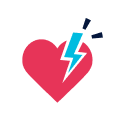Coronary artery disease
Fatty deposits in the artery
Angina, also called angina pectoris, is a type of chest pain or discomfort caused by an imbalance between what your heart needs in oxygen (oxygen demand) and what your heart receives in oxygen (oxygen supply). In other words, it’s when your heart isn’t receiving enough oxygen-rich blood.
It feels like pain, pressure, tightness, or discomfort in your chest but can also express itself in your arms, back, shoulders, neck, jaw, or tummy.
in the majority of cases (a few minutes or less)
Lasts a few seconds2
30 000 - 40 000 people
per million have chronic stable angina4Fatty deposits in the artery
Fatty deposits in the artery or blood clots partially reducing the blood flow to the heart
Spasms reducing the blood flow to the heart
Obstruction caused by fatty deposits and blood clots
Depending on the type of angina you have been diagnosed with and your risk factors, the symptoms vary from person to person in terms of location, frequency, and severity. Chest pain, chest tightness/heaviness, and fatigue are the main symptoms.
Is the following statement a myth or a fact? Try to find the right answer!
